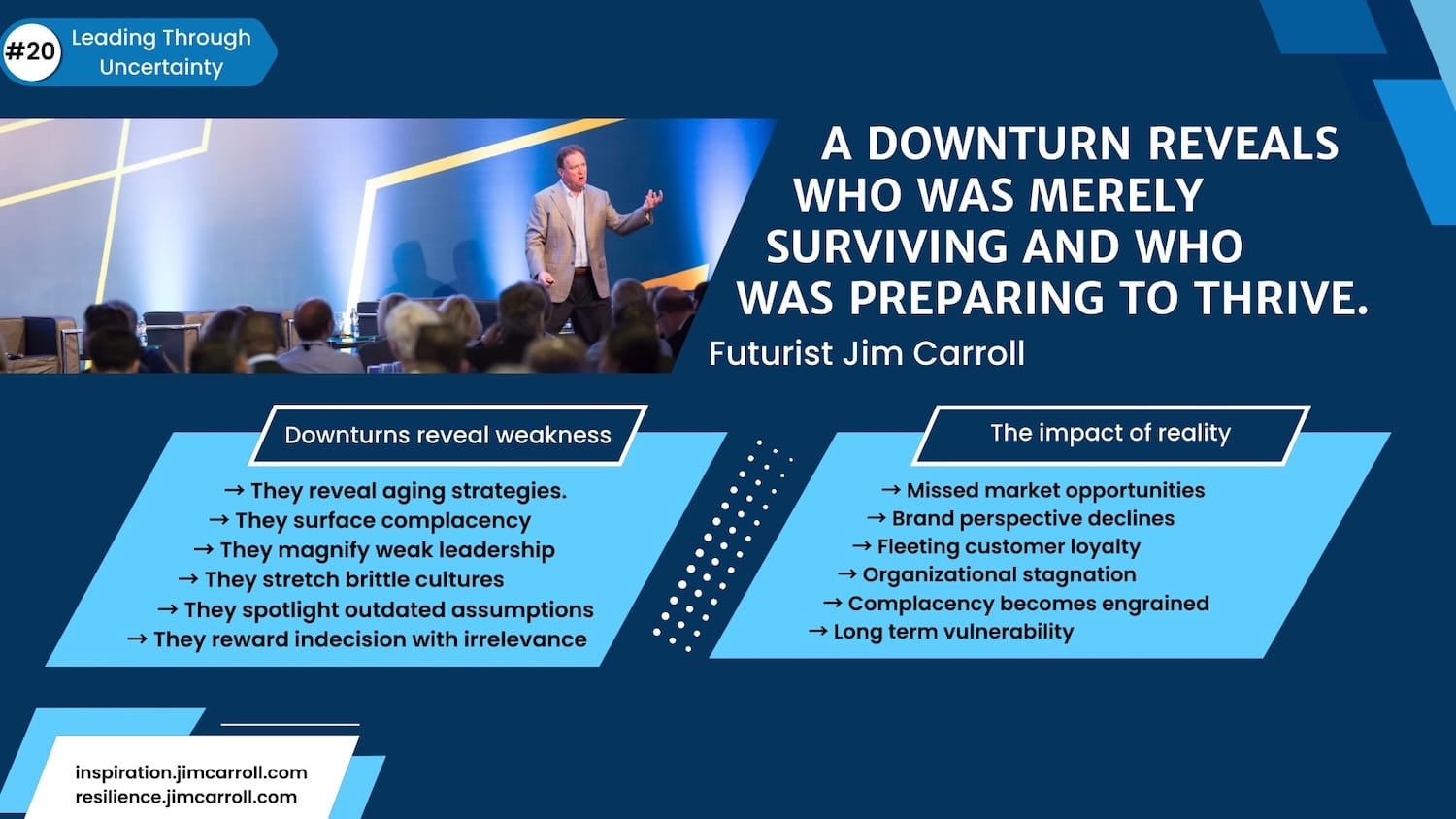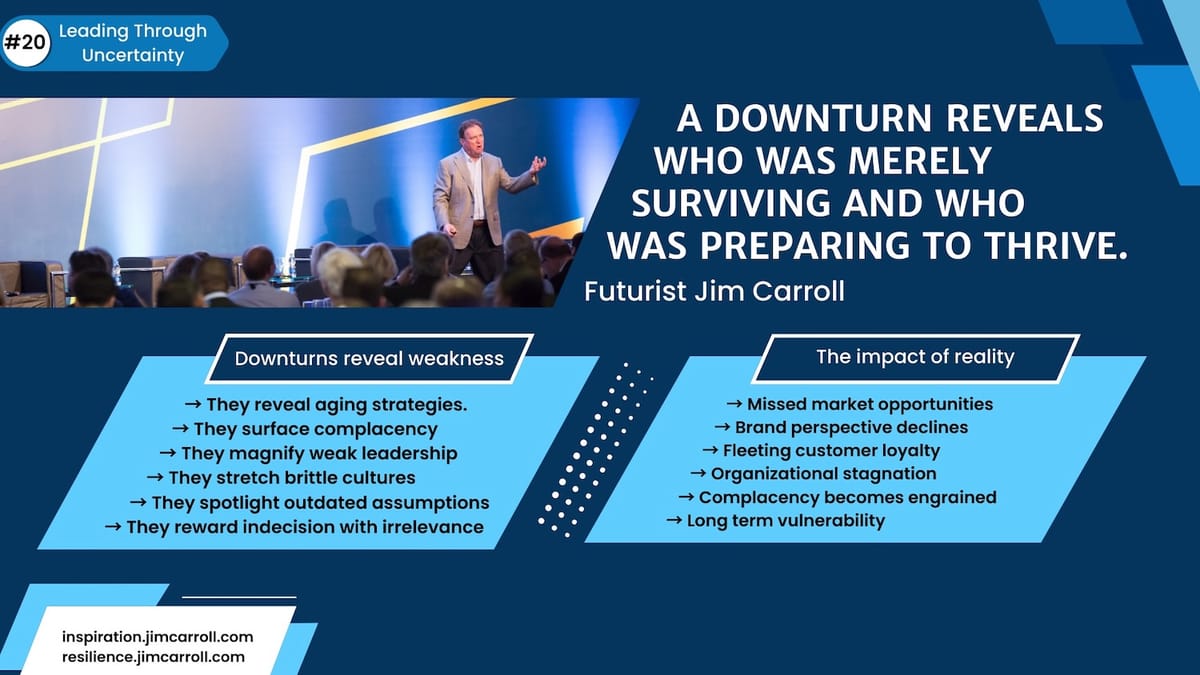"When the world slows down, winners speed up" - Futurist Jim Carroll

(Note: When I started writing this series over a month ago, I never had plans to have it turn into a book! And yet, it did. I also thought I would write about 10 posts on the theme of 'leading in uncertainty' - and then realized it would become 15 posts. Before I knew it, 20! I now see light at the end of the tunnel! The next two posts - to come Wednesday and Thursday - will actually become Chapters 1 and 2 in the Dancing in the Rain book. After that, post #25 will be the wrap-up and the closing chapter! At the same time that I've been writing these posts, I've been feeding them into my word processing software to get them into actual book format. The future happens fast!
Here’s the truth: downturns don’t slow the future. They compress it. They intensify it. They accelerate it.
When the world slows down, winners speed up. Downturns don’t delay the future—they accelerate it.
With that being the case, speed isn’t reckless. In a recession, it’s your superpower. That's because, during a downturn, it’s not just the ideas that matter, it’s how fast you move on them.
In times of uncertainty, there’s an instinct to slow down. Pause. Delay decisions. Wait for clarity.
But history—and recent experience—shows that’s exactly the wrong move. When the environment slows, the smartest companies speed up.
We just witnessed that reality on a global scale in the last few years as the pandemic took hold. If you think back to those first few months, the fact is we compressed ten years of change into just six months. Retailers became digital-first overnight. Healthcare embraced telemedicine in an instant. Manufacturers pivoted supply chains on a dime.
So what happened that allowed for this? Major trends accelerated as organizations learned something new about speed! Agility and flexibility became critical because business models shifted faster. Customers changed quickly as people became more adaptable to new interaction methods! Overall, corporate cultures that were once used to working slowly had to embrace speed - with the result that the attitude ‘it can’t be done!’ disappeared, decision-making paralysis disappeared, the slow structure was put under a microscope, old barriers to new ideas disappeared, and "get it done" became the rallying cry!
It was a fascinating time since it showed what true organizational agility looks like. Necessity didn’t just breed invention—it demanded acceleration. The rallying cry wasn’t “What if?” It was: “What’s next—and how fast can we make it real?”
That wasn't an isolated circumstance though, because history shows that speed wins in uncertainty. Research from multiple downturns tells the same story: Resilient companies move faster. They make bolder decisions. They simplify governance. They respond rapidly to cost shifts and market shocks. They act while others analyze. They reorganize for velocity and enable frontline decision-making. They accelerate when others stall.
And that gap compounds quickly. McKinsey calls it “increasing the metabolic rate of the organization.” In simpler terms: get faster—or fall behind. Speed is a superpower, and decades of analysis confirm it—resilient companies don’t just survive downturns. They move faster than their competitors, and that velocity compounds into outperformance.
Here’s what the research shows: Resilient companies that outperformed peers during macroeconomic crises were able to move faster. During the "Great Recession," they cut operating costs by $0.50 for every $1 of revenue decline, while nonresilients saw costs rise. A defining trait was their ability to improve EBITDA margins—faster.
These speed gains didn't stop once things stabilized. In the recovery, they continued to accelerate, cutting costs faster per revenue dollar. They increased leverage sooner and smarter—while others played catch-up. They made fast and bold moves to drive productivity gains. Their playbook relies on accelerated decision-making as a core strategy. Simplifying operations wasn’t just about efficiency—it was about moving faster. Top leadership teams operated differently—boosting the metabolic rate of decisions.
Speed became a strategic asset—enabled by decision-making structures that balance urgency and insight. They acted promptly—and often ahead of competitors. Long cycle times? They reacted even faster to offset costs and drive change. Business resilience was tied to agility and innovation. The ability to adapt quickly became a clear market differentiator. Fast responders gained ground; slow ones slipped. Resilient leaders cultivated a culture where teams could experiment, fail, and adapt fast.
The message was clear: change waits for no one. To thrive, you must operate at lightning speed. And above all—leaders built high-cadence teams focused on seizing opportunity in real-time.
As a futurist, I’ve watched this pattern play out repeatedly: 2001. 2008. 2020. Each crisis was a stress test. And each time, a handful of companies pulled ahead—not by being cautious, but by being bold and fast. Lots of people don't understand how important this is - and leads to the mistake many organizations make all too often. They think speed is risky. But in today’s high-velocity economy, slow is the true risk.
And here's the biggest thing we've learned. The recovery that inevitably follows favors the fast. Resilient companies don’t just move faster in the crisis—they rebound faster in the recovery. While others are still forecasting, they're already executing. They’ve built the muscles of momentum.
They’re not asking, “When will things return to normal?” They’re saying, “This is the new normal, and we’re already ahead of it.”
It comes down to this: Right now, you're making decisions that will define your post-downturn trajectory.
Ask yourself:
- are we simplifying decision-making to increase speed?
- are we empowering teams to act in real-time?
- are we using volatility to break down bureaucratic barriers?
- are we rewarding speed of learning over perfection of planning?
Because one thing is certain: the winners of tomorrow are already moving faster today.
Futurist Jim Carroll is moving at an astonishing speed in pulling together a book from this series of posts.

